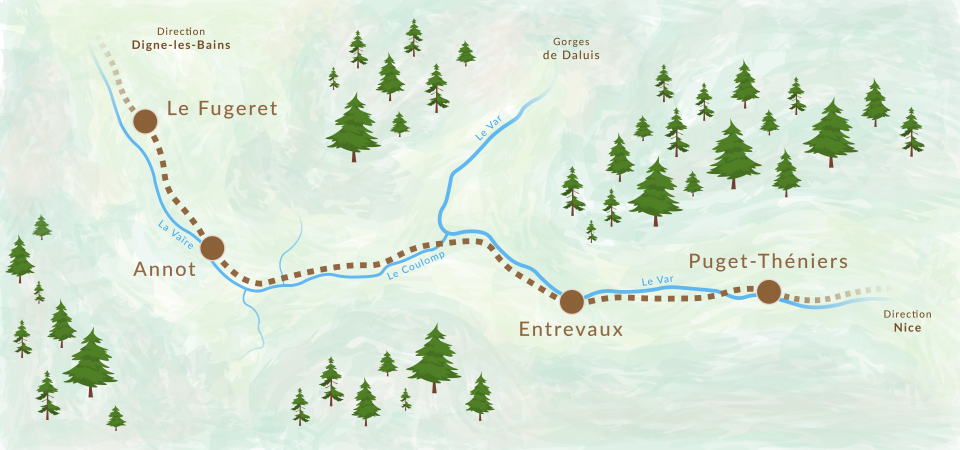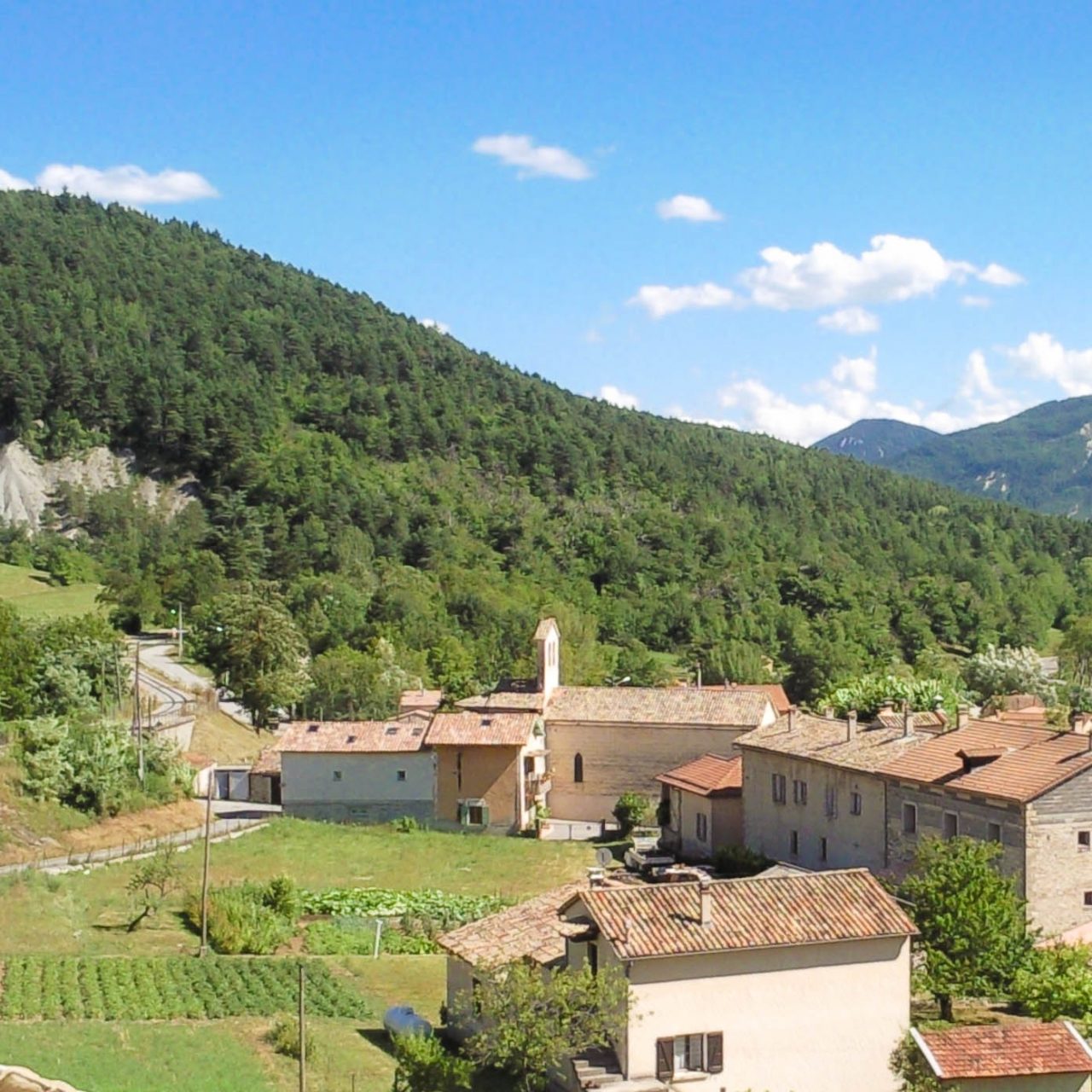The Route
From the County of Nice to the Haute Provence, from the olive tree to the chestnut trees, passing through the ancient border town of Entrevaux and discovering Annot, the land of sandstone…
From the County of Nice to the Haute Provence,
From the country of the olive tree to that of the chestnuts,
Passing through the ancient border town of Entrevaux and discovering Annot, land of sandstones...

A historic journey
from Puget-Théniers to Annot
300 m
of altitude difference
and ramps up to 30 mm/m
and ramps
up to 30 mm/m
1h20
travel
through 20 km of landscapes
through 20 km
landscape
13 large
bridges and tunnels
commissioned in 1907
commissioned
in 1907
For
special trains, extend the journey to the Fugeret
On the occasion of special trains
Extend the journey to the Fugeret
The history of the
Train des Pignes
The history of the Train des Pignes
Nice-Digne line
The first rail link project between Nice and Digne was developed in 1861 by the Dignois engineer Alphonse Beau de Rochas, but it took half a century for it to materialize. After the State decided to build it with a gauge of one meter, due to the difficulties of the relief, the Compagnie des Chemins de fer du Sud de la France began its construction in 1890.
From the monumental «Gare du Sud» in Nice, the railway line reached Puget-Théniers in 1892 while the one started in Digne joined Saint-André-les-Alpes the same year. Work between these two sections took a decisive turn from 1900 with the drilling of the Colle-Saint-Michel tunnel, 3457 meters long. For a decade, hundreds of workers worked in the mountains, building embankments and viaducts, digging trenches and tunnels, building stations up to over 1,000 metres. The train reached Entrevaux and Pont-de-gueydan in 1907, Annot in 1908 and Saint-André in 1911, finally making the junction between Nice and Digne.
The Nice – Digne line experienced prosperity, the First World War, the demographic decline of the mountains, the difficulties of the interwar period with a sequestration, the revival with the arrival of the first railcars in 1935, another world war with its acts of resistance, then new threats of closure until the end of the 20th century.
It is to preserve and promote it that its defenders created the Study Group for the Railways of Provence (Groupe d’Etude des Chemins de Fer de Provence – GECP). Since 1980 this association of volunteers operates the Train des Pignes à Vapeur on the line, now modernized and operated by the Région Sud – Provence Alpes Côte d’Azur.
The origins of a mythical name...
The “Train des Pignes”, a name and many stories!
The most folk takes us on a Christmas night, a barrier guard remained alone with his sick child found himself short of wood to heat. The crew of a train passing in the night stopped to offer him his coal. Further on, the locomotive itself ran out of fuel, the pinecones from the trees along the track fell directly into the tender of the machine, which was thus able to continue its journey.
Another more notorious story tells us that the speed of the steam trains was so low that travelers had time to get down to pick up the pignes near the railway.
Formerly unflattering, the name “Train des Pignes” crossed generations, conflicts and difficulties to be today anchored in the collective memory, representing the affection of the populations for this Provençal slow train.

The origins of a mythical name...
The “Train des Pignes”, a name and many stories!
The most folk takes us on a Christmas night, a barrier guard remained alone with his sick child found himself short of wood to heat. The crew of a train passing in the night stopped to offer him his coal. Further on, the locomotive itself ran out of fuel, the pinecones from the trees along the track fell directly into the tender of the machine, which was thus able to continue its journey.
Another more notorious story tells us that the speed of the steam trains was so low that travelers had time to get down to pick up the pignes near the railway.
Formerly unflattering, the name “Train des Pignes” crossed generations, conflicts and difficulties to be today anchored in the collective memory, representing the affection of the populations for this Provençal slow train.

Discover the villages
Puget-théniers
Benvenguda au Puget !
A bit of history: located at the confluence of the Var and Roudoule, Puget-Théniers was for a long time a border town between the Kingdom of France and the County of Savoy. Became a sub-prefecture from 1860 to 1926, it is the birthplace of Louis Auguste Blanqui, famous revolutionary under the Monarchy and the Second Empire.
Village center of the middle valley of the Var, Puget-Théniers offers all the services and shops of a small town.
Sports: hiking, swimming, tennis, rafting, canoeing… and the famous via ferrata!
At the turn of the alleys, discover the Romanesque church of the XIIIth century which shelters a descent of cross sculpted by Matthew of Antwerp (Flemish school, unique masterpiece on the department). Also present is an altarpiece by Antoine de Ronzen (1525).
Puget-théniers
Benvenguda au Puget !
A bit of history: located at the confluence of the Var and Roudoule, Puget-Théniers was for a long time a border town between the Kingdom of France and the County of Savoy. Became a sub-prefecture from 1860 to 1926, it is the birthplace of Louis Auguste Blanqui, famous revolutionary under the Monarchy and the Second Empire.
Village center of the middle valley of the Var, Puget-Théniers offers all the services and shops of a small town.
Sports: hiking, swimming, tennis, rafting, canoeing… and the famous via ferrata!

At the turn of the alleys, discover the Romanesque church of the XIIIth century which shelters a descent of cross sculpted by Matthew of Antwerp (Flemish school, unique masterpiece on the department). Also present is an altarpiece by Antoine de Ronzen (1525).
The village square hosts the statue of Maillol «the chained action», offered to the town by Georges Clémenceau in 1909 in tribute to Louis Auguste Blanqui.
Entrevaux
Benvenguda a Entrevaus !
If the din of the cannons has dissipated for a long time, the fortified city has preserved its charm of past centuries: narrow and high houses, winding streets, squares and fountains, barracks and watchtowers, ramparts and drawbridges are witnesses of ancient times that lend to reverie and ignite the imagination !
City border for 472 years between Provence and the County of Nice, ie France and Piedmont, Entrevaux saw its stronghold completely redesigned and improved by Vauban under the reign of Louis XIV.
Entrevaux is today a privileged site of tourism offering opportunities for guided and commented tours in the heart of the medieval village. Extraordinary site in the middle of olive groves, built on a narrow rocky spur and surrounded by a loop of the river Var… Vauban wanted the citadel impregnable, and it never surrendered!
From the powder magazine to the cells that held German officers prisoner during the First World War, the tour plunges you into the secrets and dark corners of the fort. Imagine what life was like in this fortress with its drawbridges, bastions, ramp, curtains, underground and enjoy beautiful views of the medieval city and its surroundings.

Entrevaux
Benvenguda a Entrevaus !
If the din of the cannons has dissipated for a long time, the fortified city has preserved its charm of past centuries: narrow and high houses, winding streets, squares and fountains, barracks and watchtowers, ramparts and drawbridges are witnesses of ancient times that lend to reverie and ignite the imagination !
City border for 472 years between Provence and the County of Nice, ie France and Piedmont, Entrevaux saw its stronghold completely redesigned and improved by Vauban under the reign of Louis XIV.
Entrevaux is today a privileged site of tourism offering opportunities for guided and commented tours in the heart of the medieval village. Extraordinary site in the middle of olive groves, built on a narrow rocky spur and surrounded by a loop of the river Var… Vauban wanted the citadel impregnable, and it never surrendered!
From the powder magazine to the cells that held German officers prisoner during the First World War, the tour plunges you into the secrets and dark corners of the fort. Imagine what life was like in this fortress with its drawbridges, bastions, ramp, curtains, underground and enjoy beautiful views of the medieval city and its surroundings.
Annot
Benvenguda a Anòt !
Nestled in the heart of a preserved environment, at the foot of the natural site of “Annot sandstone”, the medieval village of Annot contains architectural treasures bequeathed by several centuries of history.
Whether you opt for a walk in the pedestrian streets of the old center or for the walk to the chapels of «Vers la Ville» or «Vérimande», the oratories, the corbelled houses, the engraved lintels and other shops will tell you its rich past.
Classified «Station Verte de Vacances», Annot welcomes hikers and other nature lovers in all seasons.
Famous for its climbing site in the heart of sandstone, Annot attracts climbers from all over Europe.
Annot also preserves its terroir and traditions to better share them with you; whether it is local products or festivities such as the Saint Fortunat and its Bravade, the Provençal festival or the Folklore Festival.
So many opportunities to appreciate the welcome and friendliness of the Annotains.
Annot
Benvenguda a Anòt !
Nestled in the heart of a preserved environment, at the foot of the natural site of “Annot sandstone”, the medieval village of Annot contains architectural treasures bequeathed by several centuries of history.
Whether you opt for a walk in the pedestrian streets of the old center or for the walk to the chapels of «Vers la Ville» or «Vérimande», the oratories, the corbelled houses, the engraved lintels and other shops will tell you its rich past.
Classified «Station Verte de Vacances», Annot welcomes hikers and other nature lovers in all seasons.

Famous for its climbing site in the heart of sandstone, Annot attracts climbers from all over Europe.
Annot also preserves its terroir and traditions to better share them with you; whether it is local products or festivities such as the Saint Fortunat and its Bravade, the Provençal festival or the Folklore Festival.
So many opportunities to appreciate the welcome and friendliness of the Annotains.
Le Fugeret
Benvenguda au Fujairet !
After leaving the country of Annot, we enter the territory of Fugeret.
At an altitude of more than 800m, the valley suddenly widens to form a vast basin bordered by the peaks of the Puy de Rent chain.
On the steep slopes, thorny broom, oak and hazel trees grow.
At the exit of the village, in the large notch that cuts in two a vast rocky outcrop, the torrential Vaïre worked its way painfully.
The Fugeret is famous for its beautiful chestnut but also for… its curls!
Upstream of the village the profile of the valley of the Vaïre stiffens and the line must catch 175 meters of difference in less than 6 km as the crow flies to reach the entrance of the tunnel of La Colle-Saint-Michel. The railway builders, faced with this difficulty, solved it with elegance. The railway route describes a double S-shaped loop on the hillside overlooking the village, crossing three tunnels, a bridge and a viaduct, This lengthens the course a little but allows to gain about forty meters of elevation without exceeding the maximum gradients of 30 mm/ m allowed on the line. This is how the train passes twice over the station it left a few minutes before!

Le Fugeret
Benvenguda au Fujairet !
After leaving the country of Annot, we enter the territory of Fugeret.
At an altitude of more than 800m, the valley suddenly widens to form a vast basin bordered by the peaks of the Puy de Rent chain.
On the steep slopes, thorny broom, oak and hazel trees grow.
At the exit of the village, in the large notch that cuts in two a vast rocky outcrop, the torrential Vaïre worked its way painfully.
The Fugeret is famous for its beautiful chestnut but also for… its curls!
Upstream of the village the profile of the valley of the Vaïre stiffens and the line must catch 175 meters of difference in less than 6 km as the crow flies to reach the entrance of the tunnel of La Colle-Saint-Michel. The railway builders, faced with this difficulty, solved it with elegance. The railway route describes a double S-shaped loop on the hillside overlooking the village, crossing three tunnels, a bridge and a viaduct, This lengthens the course a little but allows to gain about forty meters of elevation without exceeding the maximum gradients of 30 mm/ m allowed on the line. This is how the train passes twice over the station it left a few minutes before!



